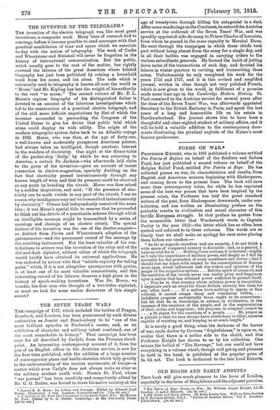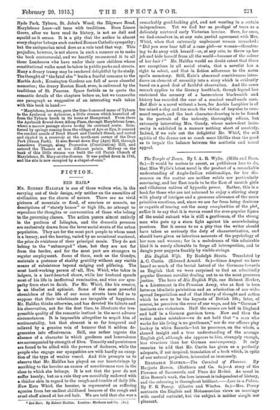OLD ROADS AND EARLY ABBEYS:I'
THIS book will give much pleasure to the lover of London, especially to the lover of Marylebone and the adjacent parishes.
• Pro Patric et Roos t Poems on War. By William Angus Knight, LL.D. London J. and J. Bennett. Ps. OIL net.] t Old Beads and Earls Alleys. By .A.unn Loofw Lee. With an Introduction by T. Fairman Ordish. F.S.A. Lorora of London Series," Vol. I. London, Mint Stock. Lao. 6d. net.]
Hyde Park, Tyburn, Bt. John's Wood, the Edgware Road, Maryleboue Lane—all teem with traditions. Even Lissom Grove, after we have read its history, is not as dull and squalid as it seems. It is a pity that the author in almost every chapter betrays such marked Roman Catholic sympathy; but the antiquarian mind does as a rule tend that way. This prejudice, however, is not shown in such a manner as to make the book controversial, and we heartily recommend it to all those Londoners who have under their care children whose constitutional walks must be taken in public parks and streets. Many a dreary tramp may be rendered delightful by its study. The thought of " dictate' elm " lends a fearful romance to the Marble Arch; Kensington Gardens are full of more cheerful memories; the dreary Euston Road, even, is enlivened by the traditions of St. Pancras. Space forbids us to quote the romantic details of the chapters before us, but we transcribe one paragraph as suggestive of an interesting walk taken with this book in hand
"Marylebone, however, gave the time-honoured name of Tyburn to the Ayebrook or lyborirno, a little stream which branched off from the Tyburn brook in its home at Hampstead. From there the Ayebrook flowed down Alleop Place, through Marylebone Lane, where a narrow passage shows today its overland route. Rein- forced by springs coming from the village of Aye or Eye, it coursed the conduit meads of Bond Street and Conduit Street, and rested and rippled in a reservoir at the north-east corner of the Deer Park (Green Park). It also Bowed down Hay (Aye) Hill, through Lansdown Passage, along Procession (Constitution) Hill, and entered the Thames at two different points. Midway on the bank of this little stream was built the old Parish Church of Marylebone, St. Mary-at-the-Bourne. It was pulled down in 1741, and the site is now occupied by a chapel-of-ease."







































 Previous page
Previous page